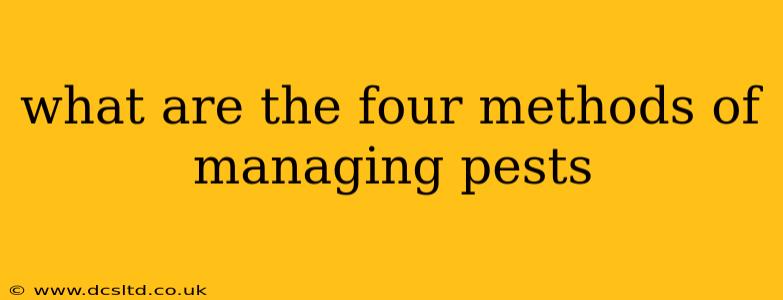The Four Main Methods of Pest Management: A Comprehensive Guide
Pest management is crucial in various sectors, from agriculture and horticulture to public health and home environments. While the specific tactics vary depending on the pest and the context, four primary methods underpin most effective pest management strategies. Understanding these methods is essential for implementing safe, effective, and environmentally responsible control measures.
Here are the four main methods of managing pests:
1. Cultural Control: Preventing Pests Before They Arrive
Cultural control focuses on manipulating the environment to make it less hospitable to pests. This proactive approach aims to prevent infestations before they even begin, reducing the need for more aggressive interventions. Effective cultural control practices often involve a combination of techniques tailored to the specific pest and environment.
Examples of Cultural Control Methods:
- Crop Rotation: Rotating crops disrupts the life cycle of pests that are specific to certain plants. This prevents pest populations from building up over time.
- Sanitation: Removing weeds, debris, and other potential hiding places eliminates breeding grounds and food sources for pests. This is particularly important in gardens and agricultural settings.
- Proper Watering and Fertilization: Maintaining healthy plants through proper watering and fertilization enhances their natural resistance to pests. Strong, vigorous plants are less susceptible to attack.
- Resistant Varieties: Planting pest-resistant varieties of crops reduces the need for pesticides. This is a powerful tool in agricultural settings.
- Physical Barriers: Using physical barriers like nets, screens, or traps can prevent pests from accessing plants or structures. This is effective for preventing entry into homes or protecting crops.
2. Biological Control: Utilizing Nature's Predators
Biological control harnesses the power of natural predators, parasites, or pathogens to suppress pest populations. This method relies on introducing natural enemies to control the target pest, offering a more sustainable and environmentally friendly approach compared to chemical control.
Examples of Biological Control Methods:
- Introducing Natural Predators: Introducing beneficial insects like ladybugs, lacewings, or praying mantises that prey on target pests.
- Employing Parasitoids: Utilizing insects or other organisms that lay their eggs in or on the pest, eventually killing it.
- Pathogen Application: Using naturally occurring bacteria, fungi, or viruses that are harmful to the pest but generally harmless to other organisms. This often involves applying a specific biological control agent.
- Sterile Insect Technique (SIT): Releasing large numbers of sterilized male insects into the environment to mate with wild females, resulting in infertile eggs and a reduction in the pest population over time.
3. Mechanical Control: Physical Removal and Trapping
Mechanical control involves physically removing or trapping pests. This is a direct and often immediate method of pest control, particularly effective for smaller infestations or specific pest types.
Examples of Mechanical Control Methods:
- Handpicking: Manually removing pests from plants or structures. This is effective for small infestations but may not be practical for large-scale problems.
- Trapping: Using various types of traps to capture and eliminate pests. Examples include sticky traps for insects, mouse traps for rodents, and pheromone traps for specific insects.
- Vacuuming: Using a vacuum cleaner to remove pests and their eggs from surfaces. This is particularly useful for removing insects or mites from carpets and furniture.
- Physical Barriers: This overlaps with cultural control but includes physical barriers like fences, screens, or netting to prevent pest access.
4. Chemical Control: Pesticides as a Last Resort
Chemical control involves the use of pesticides to kill or repel pests. While effective in many situations, it should generally be considered a last resort due to potential environmental and health impacts. Pesticides should only be used when other methods are insufficient and when used responsibly and according to label instructions.
Important Considerations for Chemical Control:
- Targeted Application: Using pesticides that are specific to the target pest to minimize harm to beneficial organisms and the environment.
- Integrated Pest Management (IPM): Combining chemical control with other methods (cultural, biological, and mechanical) for a more effective and sustainable approach.
- Safety Precautions: Always follow label instructions carefully and take necessary precautions to protect yourself and the environment.
Choosing the Right Method: The most effective pest management strategy often involves an integrated approach, combining several of these methods. A comprehensive assessment of the situation, considering the type of pest, the extent of the infestation, the environment, and potential risks, is crucial for developing a successful and responsible pest management plan.
